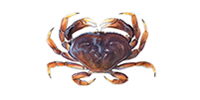Thank you for visiting the Seafood Selector. EDF is planning a new approach to providing information to consumers about good seafood choices. Please come back soon for updates.
Crab

Dungeness crab, © Amadeo Bachar
Recommended servings per month
| Contaminant | Men | Women | Kids 6-12 | Kids 0-5 | |
|---|---|---|---|---|---|
| Blue crab | Mercury | 4+ | 4+ | 4+ | 4+ |
| Dungeness crab | Mercury | 4+ | 4+ | 4+ | 4+ |
| Red king crab (imported) | Unknown | 4+ | 4+ | 4+ | 4+ |
| Blue king crab (imported) | Unknown | 4+ | 4+ | 4+ | 4+ |
| Red king crab (U.S.) | Mercury | 4+ | 4+ | 4+ | 4+ |
| Blue king crab (U.S.) | Mercury | 4+ | 4+ | 4+ | 4+ |
| Snow crab (US) | Mercury | 4+ | 4+ | 4 | 4 |
| Southern tanner crab | Mercury | 4+ | 4+ | 4 | 4 |
| Stone crab | Mercury | 4 | 4 | 4 | 4 |
| Jonah Crab | Unknown |
Eco details:
- Most species of crabs are caught in pots or traps that are designed to reduce bycatch and habitat damage.
- Red and blue king crabs, harvested for their legs, come primarily from a poorly managed Russian fishery — look for U.S. king crabs instead.
- Alaskan snow crabs from the Bering Sea have recovered from overfishing and the fishery is well-managed and closely monitored.
- Although blue crabs (hardshell and softshell) can generally withstand heavy fishing, habitat degradation in the Chesapeake Bay and bycatch in Gulf of Mexico shrimp fisheries continue to be concerns.
- Approximately 20% of Chesapeake blue crabs are caught on hookless "trot lines", which have the added benefit of zero bycatch since the bait is tied directly to the line. These are considered an "Eco-Best" if you can find them in the market.




